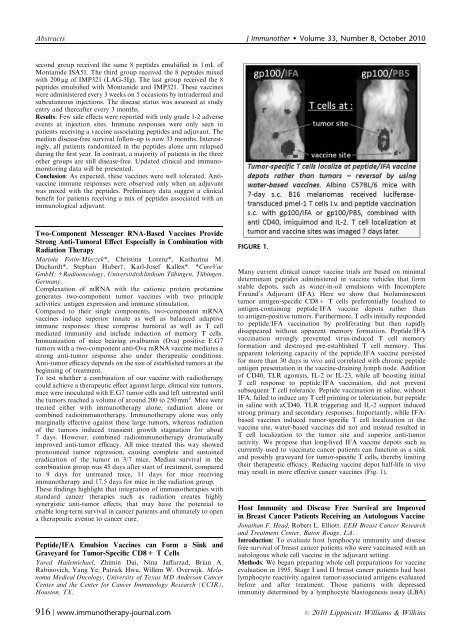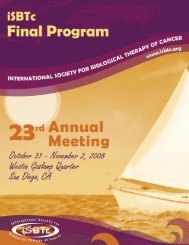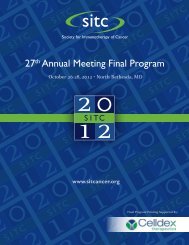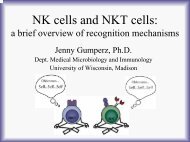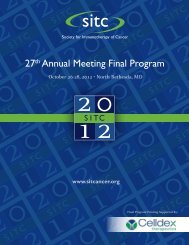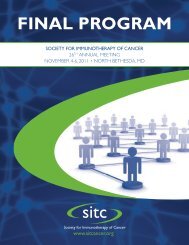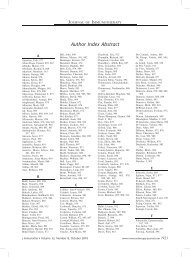Abstracts for the 25th Annual Scientific Meeting of the International ...
Abstracts for the 25th Annual Scientific Meeting of the International ...
Abstracts for the 25th Annual Scientific Meeting of the International ...
Create successful ePaper yourself
Turn your PDF publications into a flip-book with our unique Google optimized e-Paper software.
<strong>Abstracts</strong> J Immuno<strong>the</strong>r Volume 33, Number 8, October 2010<br />
second group received <strong>the</strong> same 8 peptides emulsified in 1 mL <strong>of</strong><br />
Montanide ISA51. The third group received <strong>the</strong> 8 peptides mixed<br />
with 200 mg <strong>of</strong> IMP321 (LAG-3Ig). The last group received <strong>the</strong> 8<br />
peptides emulsified with Montanide and IMP321. These vaccines<br />
were administered every 3 weeks on 5 occasions by intradermal and<br />
subcutaneous injections. The disease status was assessed at study<br />
entry and <strong>the</strong>reafter every 3 months.<br />
Results: Few side effects were reported with only grade 1-2 adverse<br />
events at injection sites. Immune responses were only seen in<br />
patients receiving a vaccine associating peptides and adjuvant. The<br />
median disease-free survival follow-up is now 33 months. Interestingly,<br />
all patients randomized in <strong>the</strong> peptides alone arm relapsed<br />
during <strong>the</strong> first year. In contrast, a majority <strong>of</strong> patients in <strong>the</strong> three<br />
o<strong>the</strong>r groups are still disease-free. Updated clinical and immunomonitoring<br />
data will be presented.<br />
Conclusion: As expected, <strong>the</strong>se vaccines were well tolerated. Antivaccine<br />
immune responses were observed only when an adjuvant<br />
was mixed with <strong>the</strong> peptides. Preliminary data suggest a clinical<br />
benefit <strong>for</strong> patients receiving a mix <strong>of</strong> peptides associated with an<br />
immunological adjuvant.<br />
Two-Component Messenger RNA-Based Vaccines Provide<br />
Strong Anti-Tumoral Effect Especially in Combination with<br />
Radiation Therapy<br />
Mariola Fotin-Mleczek*, Christina Lorenz*, Katharina M.<br />
Duchardt*, Stephan Huberw, Karl-Josef Kallen*. *CureVac<br />
GmbH; w Radiooncology, Universita¨tsklinikum Tübingen, Tübingen,<br />
Germany.<br />
Complexation <strong>of</strong> mRNA with <strong>the</strong> cationic protein protamine<br />
generates two-component tumor vaccines with two principle<br />
activities: antigen expression and immune stimulation.<br />
Compared to <strong>the</strong>ir single components, two-component mRNA<br />
vaccines induce superior innate as well as balanced adaptive<br />
immune responses: <strong>the</strong>se comprise humoral as well as T cell<br />
mediated immunity and include induction <strong>of</strong> memory T cells.<br />
Immunization <strong>of</strong> mice bearing ovalbumin (Ova) positive E.G7<br />
tumors with a two-component anti-Ova mRNA vaccine mediates a<br />
strong anti-tumor response also under <strong>the</strong>rapeutic conditions.<br />
Anti-tumor efficacy depends on <strong>the</strong> size <strong>of</strong> established tumors at <strong>the</strong><br />
beginning <strong>of</strong> treatment.<br />
To test whe<strong>the</strong>r a combination <strong>of</strong> our vaccine with radio<strong>the</strong>rapy<br />
could achieve a <strong>the</strong>rapeutic effect against large, clinical size tumors,<br />
mice were inoculated with E.G7 tumor cells and left untreated until<br />
<strong>the</strong> tumors reached a volume <strong>of</strong> around 200 to 250 mm 3 . Mice were<br />
treated ei<strong>the</strong>r with immuno<strong>the</strong>rapy alone, radiation alone or<br />
combined radioimmuno<strong>the</strong>rapy. Immuno<strong>the</strong>rapy alone was only<br />
marginally effective against <strong>the</strong>se large tumors, whereas radiation<br />
<strong>of</strong> <strong>the</strong> tumors induced transient growth stagnation <strong>for</strong> about<br />
7 days. However, combined radioimmuno<strong>the</strong>rapy dramatically<br />
improved anti-tumor efficacy. All mice treated this way showed<br />
pronounced tumor regression, causing complete and sustained<br />
eradication <strong>of</strong> <strong>the</strong> tumor in 3/7 mice. Median survival in <strong>the</strong><br />
combination group was 45 days after start <strong>of</strong> treatment, compared<br />
to 9 days <strong>for</strong> untreated mice, 11 days <strong>for</strong> mice receiving<br />
immuno<strong>the</strong>rapy and 17.5 days <strong>for</strong> mice in <strong>the</strong> radiation group.<br />
These findings highlight that integration <strong>of</strong> immuno<strong>the</strong>rapies with<br />
standard cancer <strong>the</strong>rapies such as radiation creates highly<br />
synergistic anti-tumor effects, that may have <strong>the</strong> potential to<br />
enable long-term survival in cancer patients and ultimately to open<br />
a <strong>the</strong>rapeutic avenue to cancer cure.<br />
Peptide/IFA Emulsion Vaccines can Form a Sink and<br />
Graveyard <strong>for</strong> Tumor-Specific CD8+ T Cells<br />
Yared Hailemichael, Zhimin Dai, Nina Jaffarzad, Brian A.<br />
Rabinovich, Yang Ye, Patrick Hwu, Willem W. Overwijk. Melanoma<br />
Medical Oncology, University <strong>of</strong> Texas MD Anderson Cancer<br />
Center and <strong>the</strong> Center <strong>for</strong> Cancer Immunology Research (CCIR),<br />
Houston, TX.<br />
FIGURE 1.<br />
Many current clinical cancer vaccine trials are based on minimal<br />
determinant peptides administered in vaccine vehicles that <strong>for</strong>m<br />
stable depots, such as water-in-oil emulsions with Incomplete<br />
Freund’s Adjuvant (IFA). Here we show that bioluminescent<br />
tumor antigen-specific CD8+ T cells preferentially localized to<br />
antigen-containing peptide/IFA vaccine depots ra<strong>the</strong>r than<br />
to antigen-positive tumors. Fur<strong>the</strong>rmore, T cells initially responded<br />
to peptide/IFA vaccination by proliferating but <strong>the</strong>n rapidly<br />
disappeared without apparent memory <strong>for</strong>mation. Peptide/IFA<br />
vaccination strongly prevented virus-induced T cell memory<br />
<strong>for</strong>mation and destroyed pre-established T cell memory. This<br />
apparent tolerizing capacity <strong>of</strong> <strong>the</strong> peptide/IFA vaccine persisted<br />
<strong>for</strong> more than 30 days in vivo and correlated with chronic peptide<br />
antigen presentation in <strong>the</strong> vaccine-draining lymph node. Addition<br />
<strong>of</strong> CD40, TLR agonists, IL-2 or IL-23, while all boosting initial<br />
T cell response to peptide/IFA vaccination, did not prevent<br />
subsequent T cell tolerance. Peptide vaccination in saline, without<br />
IFA, failed to induce any T cell priming or tolerization, but peptide<br />
in saline with aCD40, TLR triggering and IL-2 support induced<br />
strong primary and secondary responses. Importantly, while IFAbased<br />
vaccines induced tumor-specific T cell localization at <strong>the</strong><br />
vaccine site, water-based vaccines did not and instead resulted in<br />
T cell localization to <strong>the</strong> tumor site and superior anti-tumor<br />
activity. We propose that long-lived IFA vaccine depots such as<br />
currently used to vaccinate cancer patients can function as a sink<br />
and possibly graveyard <strong>for</strong> tumor-specific T cells, <strong>the</strong>reby limiting<br />
<strong>the</strong>ir <strong>the</strong>rapeutic efficacy. Reducing vaccine depot half-life in vivo<br />
may result in more effective cancer vaccines (Fig. 1).<br />
Host Immunity and Disease Free Survival are Improved<br />
in Breast Cancer Patients Receiving an Autologous Vaccine<br />
Jonathan F. Head, Robert L. Elliott. EEH Breast Cancer Research<br />
and Treatment Center, Baton Rouge, LA.<br />
Introduction: To evaluate host lymphocyte immunity and disease<br />
free survival <strong>of</strong> breast cancer patients who were vaccinated with an<br />
autologous whole cell vaccine in <strong>the</strong> adjuvant setting.<br />
Methods: We began preparing whole cell preparations <strong>for</strong> vaccine<br />
evaluation in 1995. Stage I and II breast cancer patients had host<br />
lymphocyte reactivity against tumor-associated antigens evaluated<br />
be<strong>for</strong>e and after treatment. Those patients with depressed<br />
immunity determined by a lymphocyte blastogenesis assay (LBA)<br />
916 | www.immuno<strong>the</strong>rapy-journal.com r 2010 Lippincott Williams & Wilkins


